Report of Attending the OMAE Conference in San Francisco by Kenji Sasa
The 33rd International Conference on Ocean, Offshore and Arctic Engineering (OMAE2014) was held in San Francisco, USA, from June 8 to 12, 2014. The chief organizer was Prof. Ronald Yeung, who is one of the most famous researchers in ship hydrodynamics. In an opening session, it was reported that the number of accepted papers was around 970, which is the new record in the conference. I saw many participants in the conference from NTNU, from professors to PH.D. Candidates. My research theme is the development of seakpeeing numerical models, the accumulation of actual sea data by the onboard observation, and the combination with numerical weather forecasting models, from viewpoint of enhancing the practical weather routing system. My presentation was related on the numerical consideration of failed wave forecasts on the regular ferry route in the Pacific Ocean, Tohoku District, Japan; in which the meso-meteorological model, WRF, and the shallow water wave model, SWAN, are used. In this conference, main topics were renewable energies, CFD, hydrodynamics, structural dynamics, nonlinear fluid and structure interaction problems, etc. I have a lot of necessary themes to proceed my study, such as hydroelasticity problems in slamming and sloshing, which are being discussed here in NTNU. I thought I wanted to achieve the current study step by step, and must apply the actual sea data in the future.
The final banquet was held on a chartered cruise ship in San Francisco Bay, and it seemed that the participants enjoyed the interaction with other participants and beautiful scenes of San Francisco viewed from sea. The next conference in 2017 will be held in Trondheim, Norway, so I am looking forward to joining it in the future. (June 2014)

(Left) A scene of opening session, (Right) View of San Francisco from a cruise ship at the final banquet
Report of Visiting ECM by Kazuhiro Iijima
During my staying at ECN with support of the Brain-Circulation Program, I had a chance to visit ECM (Ecole Centrale de Marseille) from 16 to 17 September 2013, in Marseille, France, and to see the experiment facilities there. In this visiting, Dr. Hirotada Hashimoto also accompanied me. The contact person at ECM was Prof. Bernard Molin.
On the first day, we visited an experimental facility of wind-wave channel (tunnel), called irphe of Marseille University. This facility has been used not only for engineering purposes such as the analysis of behavior of a floating offshore wind turbine, but also for scientific joint study on the mechanism of heat exchange through the ocean surface and instability phenomena of nonlinear waves. It is featured in being able to take more than 15 m for the wind fetch and thus to realize the situation very similar to natural winds. Next we were taken to the commercial basin called EGO First, which can generate the wave, wind, and current at the same time. What should be noteworthy here is that ECM can use this basin with free of charge by the financial support from the country government, despite being emphasized as the commercial basin. With this special advantage, ECM has carried out experiments freely to certain extent and organized student internships up to now.
On the second day, Dr. Olivier Kimmoun guided us to other experimental facilities at ECM. One of them was a smaller-size 2D water channel where an experiment was timely being done to simulate the wave generation by landslide. At another 2D water channel, we could see an experiment measuring the impulsive pressure. Furthermore, we had a look at small tank for sloshing experiments and a 6-degree-of-freedom excitation apparatus called Hexapod (which was available also at ECN and IFREMER).
In the afternoon, by request, I gave a lecture entitled "Floating Offshore Wind Turbine Projects in Japan". Since the audience were mostly new commers from September in the master course having various backgrounds, the explanation started from fundamentals like what and why is the wind-power generation, and extended to the project of renewable energies in Japan. We were highly indebted to Prof. B. Molin, Dr. O. Kimmoun and Dr. F. Remy for their kind hospitality. (June 2014)
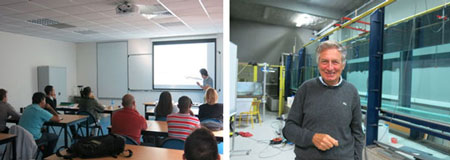
(Left) Dr. Iijima giving a lecture at ECM, (Right) Prof. Bernard Molin of ECM
Report of Visiting IFREMER by Kazuhiro Iijima
Taking advantage of staying at ECN, I had a chance to visit IFREMER (French Research Institute for Marine Exploration) in Brest, France, on 2 September 2013, and to see the experimental facilities. The contact person at IFREMER was Mr. Marc Boulluec. This visit could contribute to widening the research network, which is one of the objectives in the Brain-Circulation Program. Exchanging the information on the wind-power generation in the ocean was another objective, because IFREMER plays a part in the development of marine renewable energies in France.
The length of the model basin at IFREMER is 50 m but the depth is 10 m. This basin is used for experiments related to the acoustic equipment and ocean-bottom drilling and exploration using risers. It is just in the 1990s (rather new) that the wave generator (plunger type with two segments) was installed. By equipping with blowers (4 in each of 3 rows), they can conduct experiments in winds and waves for confirming the performance of floating-type devices to be used for utilization of marine renewable energies. I had also a visit to a facility for doing experiments on the strength, such as the experiments of composite-fiber mooring lines, pressure vessel, and long-term reliability regarding the corrosion of materials.
In the afternoon after lunch, the exchange of information on the research of renewable energies was made. I have provided the information on the two projects in Japan; Fukushima wind-firm project and Goto offshore project on the floating-type wind-power generation. Furthermore, explained was the experiments of a floating platform for wind-power generation conducted at four universities in Japan, including Osaka University. In return, Mr. Boulluec explained the project, called 'Windflo', of the development of a floating platform for the wind-power generation in the ocean, whose experiment was conducted at IFREMER.
In addition, over the weekend, Mr. Boulluec and Mr. Michinori Ikeda at JAMSTEC who stayed for longer period at IFREMER kindly took me to a tour to the coastal area where 'Amoco Cadiz' run aground, known as a famous marine disaster, and also to its monument. (June 2014).
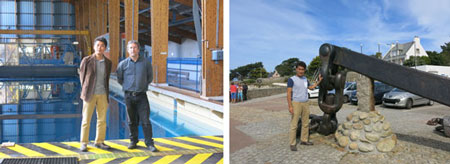
(Left) In front of the model basin with Mr. Boulluec, (Right) Anchor of Amoco Cadiz, salvaged after the wreck.
Staying Report from NTNU by Kenji Sasa
A month has passed since I arrived at NTNU in Trondheim, Norway, on February 5, 2014. The direction of my study seems to fix gradually, through some discussions with Prof. Odd M. Faltinsen, my supervisor. My affiliation is AMOS (Centre of Autonomous Marine Operations and Systems), which is one of the sections in the department of marine technology. Needless to say, Prof. Faltinsen is one of the greatest researchers in the field of marine technology and ocean engineering, and has nurtured many talented researchers from all over the world for decades. I really appreciate an opportunity to study in such an excellent environment. My main research theme is development of safety evaluation during the international maritime transportation. Current version of the weather routing still depends largely on empirical rules, especially in the ship performance in heavy seas. It is necessary to apply seakeeping theories for the part of safety evaluation. In NTNU, I am studying on the mutual-linked theoretical estimation on the engine thrust deduction, slowdown mechanism, propeller racing and fuel consumption with the ship motions and added resistance in waves. Now I am referring some studies by Prof. Faltinsen with collaborated researchers, in order to reproduce the ship performance in heavy seas accurately. Secondly, consideration of slamming, green water effect is inevitable sooner or later, as a strongly nonlinear problem of hydroelasticity. I think I must think about that point, too. I also have attended two lectures "High Speed" and "Hydro 1" for master and Ph.D students, and realized the level of lecture content pretty high. On the other hand, NTNU works on enthusiastic educational campaigns for younger people. I had an opportunity to see one of the events performed in the facilities of hydraulic experiments of MARINTEK, in front of many local high school students. I think that those state-of-the-art researches and education activities make Norway the leading nation of marine technology and ocean engineering. I have to take advantage of the excellent environment of NTNU, and learn various things while I stay here. (March, 2014)
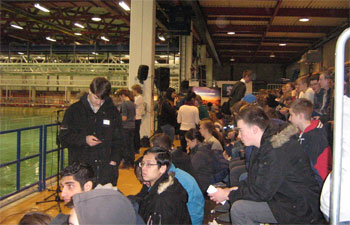
View of an educational event for local high school students
Staying Report from NTNU by Hidetaka Senga
Two months have passed since I arrived at NTNU in Trondheim, Norway. My research theme is the prediction and suppression of Vortex Induced Vibration (VIV) of marine risers; which is one of the fluid-structure interaction problems. I am collaborating with Prof. Carl Martin Larsen, who has carried out many experiments in this field and also developed a numerical scheme (VIVANA) for predicting VIV of slender structures. During my stay at NTNU, I am going to carry out some forced-motion experiments using a rigid cylinder model with several appendages in a towing tank, details of which are now being discussed with Prof. Larsen and staff. In general, the trajectories used in the forced-motion experiments are symmetric, such as a sinusoidal or orbital shape. This time, some actual trajectories of a flexible riser model, obtained from NDP (Norwegian Deepwater Program) High Mode VIV Tests, will be used. Actual trajectories of riser's cross-section are not symmetric in inline and transverse directions, and the difference in the trajectory affects greatly the hydrodynamic forces on risers. On the other hand, measured fluid forces on a rigid cylinder in this experiment will be compared with the results of numerical calculations using a 3D vortex method.
At NTNU, I am working at an office for visiting professors and visiting researchers, and its capacity is for 4 people. I have shared the room with 3 researchers up to now. All of them stayed at NTNU for their Ph. D defences. Even though the research themes were different each other, I was impressed with their attitude to the research. I will attend a lecture “Marine Dynamics” given by Prof. Larsen from this month to next month.
One of my friends is a Ph. D candidate, whose name is Mats Jørgen Thorsen, in Prof. Larsen's laboratory. His research theme is the time-domain analysis of VIV. His first journal paper is now in review process, and I am looking forward to acceptance of his paper and having a look at the printed version. (March, 2014)
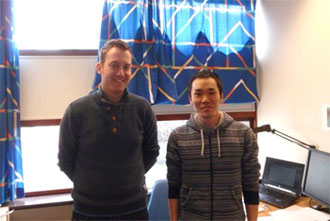
With Ph. D candidate Mats Jørgen Thorsen
Intermediate Report from ECN by Kazuhiro Iijima
It has been three months since I started my stay. I am at LHEEA (Laboratoire de Recehrche en Hydrodynamique, Energetique et Environnment Atmospherique), ECN (Ecole Centrale de Nantes). It is an indisputable fact that Ecole Centrale has educated and turned out numbers of elites of France. And, LHEEA, in particular, is attracting specialists on fluid dynamics. I am now involved in a tank test project for offshore wind turbine, and taking part in the scale model design for the test. As a structural engineer who has interests in fluid-structure interaction, I am happy to have such an occasion to learn the front line of the numerical hydrodynamics. LHEEA could be regarded as a hub for SPH (Smoothed Particle Hydrodynamics) in marine applications. Therefore, it is not rare to see SPH researchers who belong to other institutions, paying visit at LHEEA for exchange. For example, I had an opportunity to attend lectures by specialists from INSEAN on strongly-nonlinear fluid structure ship dynamics, which was very interesting and stimulating. Stimulating are even the daily talks with young staffs/researchers during lunch time. The topics include the researches, education, social system, education system, etc. I feel happy when I find sympathy about them.
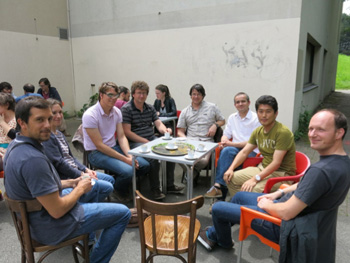
Cafe after lunch
Intermediate Report from ECN by Hirotada Hashimoto
I have started to work at Ecole Centrale de Nantes (ECN) in France from 14th March 2013 under the JSPS (Japan Society for the Promotion of Science) strategic young researcher overseas visits program for accelerating brain circulation. The charge of collaborative partners at ECN is Prof. Pierre Ferrant, the head of LHEEA Lab., and the substantive partner is Prof. David Le Touzé. Prof. Touzé is a young professor but is known as the one of world’s leaders in the field of Smoothed Particle Hydrodynamics. I have discussed with David and his colleagues, and then decided to collaborate on the following topics.
1. Systematic comparisons between MPS and SPH methods
2. Implementation of advanced scheme/algorithm of SPH into MPS
3. Development of a coupled MPS and FEM method for nonlinear fluid-structure interactions
4. Large-scale calculations by the particle methods
Dr. Nicolas Grenier of a post-doctoral researcher, Dr. Salvatore Marrone of a visiting researcher from INSEAN, and Dr. Guillaume Oger of an research associate are partners for the first, second, and third & fourth subjects, respectively. There are many post-doctoral researchers and PhD candidates in the DyRaC (Fast dynamics flows and multiphysics coupling) research group, who are financially supported by research funds from industries and EU projects. I suppose they firstly invest in human research resources than experimental ones, and it would lead to the world’s top level experimental facilities and substantial research budgets as a result. Based on the SPH-Flow code developed by ECN, they have launched a software/consultant company named HydrOcean. They divide the R&D work; the latest scheme/algorithm and the application to academic problems are researched by ECN, and the implementation into the software and further development are done by HydrOcean. Thanks to this efficiently managed research environment, ECN DyRaC group can keep their research level as world's top in the SPH field. Recently, I have a good friendship with Dr. Pierre-Emmanuel Guillerm to discuss ship stability and manoeuvrability in waves. He is a delegation of France in ITTC manoeuvring committee. I will try to have a chance to collaborate with him too.
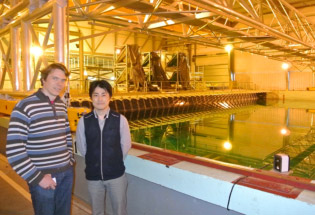
With Prof. David







